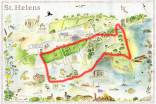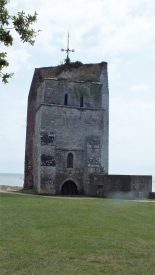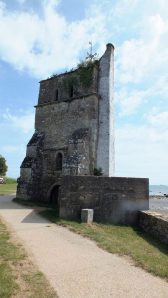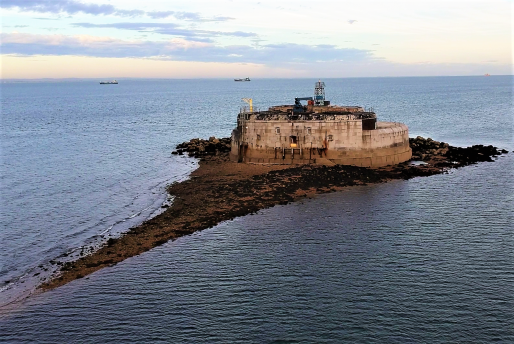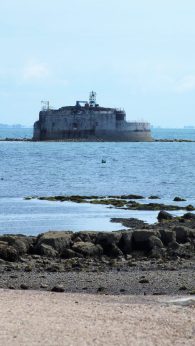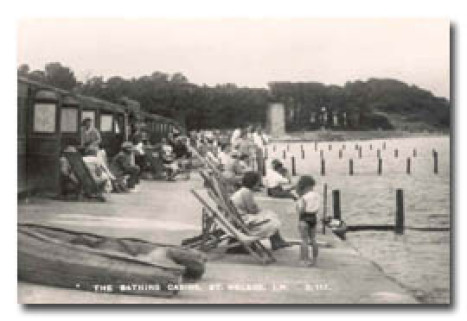The Old Church and the Sea Wall
The Old Church
A priory at St Helens was founded after the Norman Conquest by French Benedictine monks. The church was rebuilt in Norman style to serve both parish and priory. It was dedicated to St Helena, mother of the Roman Emperor Constantine, from whom the village subsequently took its name. The tower was added in the 13th century during the reign of Henry III. The Benedictine community in St Helens survived for over 300 years until financial problems led to it disbanding in 1414. The property was given to Eton College who owned it until 1799 but failed to maintain it, so the church gradually fell into disrepair. Its exposed position became even more acute in the 1620s when Sir Hugh Myddleton built an embankment across the harbour from the duver (dunes). Limestone rocks making up the foreshore had protected the church but were now used in the construction of the new embankment, which only lasted eight years.
Seamark
Another naval connection is from the following story:
In the 1630s, the sea defences were further undermined by the tenant of the Priory, who sold off the church stones. A dispute arose with his parishioners, but it’s likely that they too were removing stones for their own purposes. Blocks of soft sandstone from which the church was built – known as ‘Holy Stones’ – were used by sailors of vessels anchored off St Helens to ‘holystone the decks’ – meaning to scour and whiten them. The church was left jutting out on a peninsula, washed on three sides by the sea. Eventually only the tower remained and this was subsequently bricked up and painted white as a seamark for Navy ships in 1719.
The Fort
The Royal Commissions Report of 1860 contained a proposal to build a fort between Nettlestone Point and Bembridge at St Helens Point thus stopping any covert landings along the coastal pathways between. However, this was never built and was eventually replaced by St Helens Fort just off the coast. St Helens Fort is a sea fort in the Solent close to the Isle of Wight, one of the Palmerston Forts near Portsmouth. It was built as a result of the Royal Commission on the Defence of the United Kingdom of 1859, in order to protect the St Helens anchorage. Construction began in 1865 and was completed in 1878, at a cost of £123,311. It suffered badly from subsidence which forced many changes to the plans, ending up with two 10-inch 18-ton rifled muzzle-loading (RML) guns to landward and one 12.5- inch 38-ton RML gun to seaward.
The Fort was used as a navigational lighthouse during peacetime. Daughter of lighthouse keepers, 15 year old Ethel Langton and her dog Badger were once stranded there for three days and nights after her parents had rowed ashore to the shops. The weather was very rough and they could not return. Every four hours she had to climb a steep ladder to check on the lighthouse lamps. On the third day Frederick and George Attrill along with George Smith managed to reach the Fort and found Ethel asleep. She was awarded the Lloyds bronze medal for meritorious services. BBC’s Dr Who and the Sea Devils was filmed there in the 1970s
Gun Emplacement
The Island was in full defensive swing in the lead up to and during the 2nd World War as it was seen as being in the forefront of the battle area. It was very likely that a German invasion would try to take the Isle of Wight in order to have a secure beachhead and thus allow them to launch their blitzkrieg method of advance easily into the mainland. With this in mind the War Office devised several defence mechanisms that in the event of an evasion could be used to slow down any advancing forces. One of these methods was the deployment of several pillboxes, carefully positioned throughout the Island. Abutting the wall on the beach at St Helens Duver, there is a pill box. As there has been a great deal of work carried out on the sea wall at the Duver the actual pillbox can’t really be discerned from that of the wall to really gain an idea of the size. It is presumed that the pillbox acted as a small gun emplacement and shelter.
Nodes Point Battery
From outside the café look back up the hill and you can see a holiday camp.
At the top of the hill was a Battery, still visible from the sea. At the end of the nineteenth century a proposal based on the Montgomery Committee report saw a need for extra battery position to be built to cover the north-east approaches. So from 1901-04 a battery of two 9.2-inch guns and two 6-inch guns were installed. The further 1905 Owen report disposed of the 6-inch guns and kept only the larger 9.2-inch guns. In 1918 a 4.7-inch Q.F. gun was installed on one of the vacant 6-inch gun emplacements and remained until 1928 when St Helens Roads was designated an examination area with a need for heavy fire power to cover it. Therefore two 6-inch guns were added in 1932. At the outbreak of war in 1940 mantlets for aerial protection were fitted for the 6-inch guns and additional metal steel covers were fitted to the 9.2-inch guns offering the viewer a turret like effect. At the end of the war in 1945 the Battery was mothballed. It was used by the Territorial Army for training exercises from time to time up to the dissolution of the costal artillery in 1956. The 9.2-inch guns were disposed of in 1954 and the rest of the guns were then dismantled and sold off for scrap and the site sold into private ownership.
Previous
Next


